Giải pháp ước lượng thời gian tới để định vị tàu biển dựa trên tín hiệu AIS
Nowadays, global navigation satellite systems
(GNSS) play the main role in navigating and
positioning of marine vessels. However, in order to
overcome the risk of weak signals of GNSS, another
positioning system should be recommended as the
backup system. In marine vessels, an automatic
identification system (AIS) is used to provide
voyage information and vessel information such as:
MMSI (Maritime Mobile Service Identify), speed
over ground, ship position, course over ground
(COG), heading for collision avoidance and vessel
traffic tracking. Inspite of the fact that AIS is a
communication system, the parameters of AIS
signals could be used to calculate the position of
the vessel. Therefore, this paper proposes the new
method for marine vessel positioning based on AIS
signals. The positioning progress is implemented
based on receiving the AIS signals emitted from at
least three AIS base stations reached to AIS
receiver on the marine vessel thanks to time-ofarrival (TOA) methodology. The measuring error of
TOA method is assessed by Cramer-Rao Lower
Bound (CRLB). Simulation results showed the
various effects to the performance of the TOA
method with AIS signals
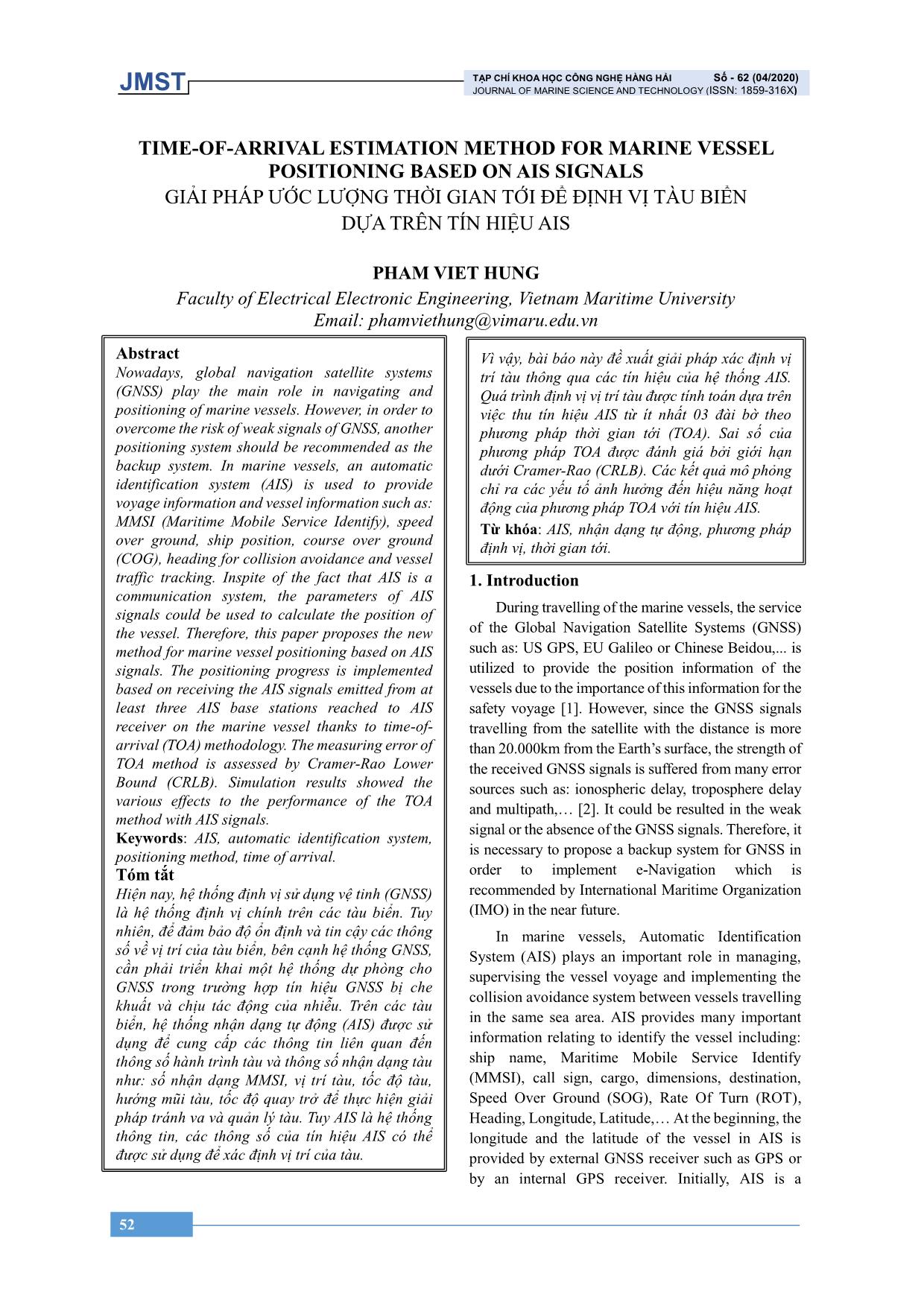
Trang 1
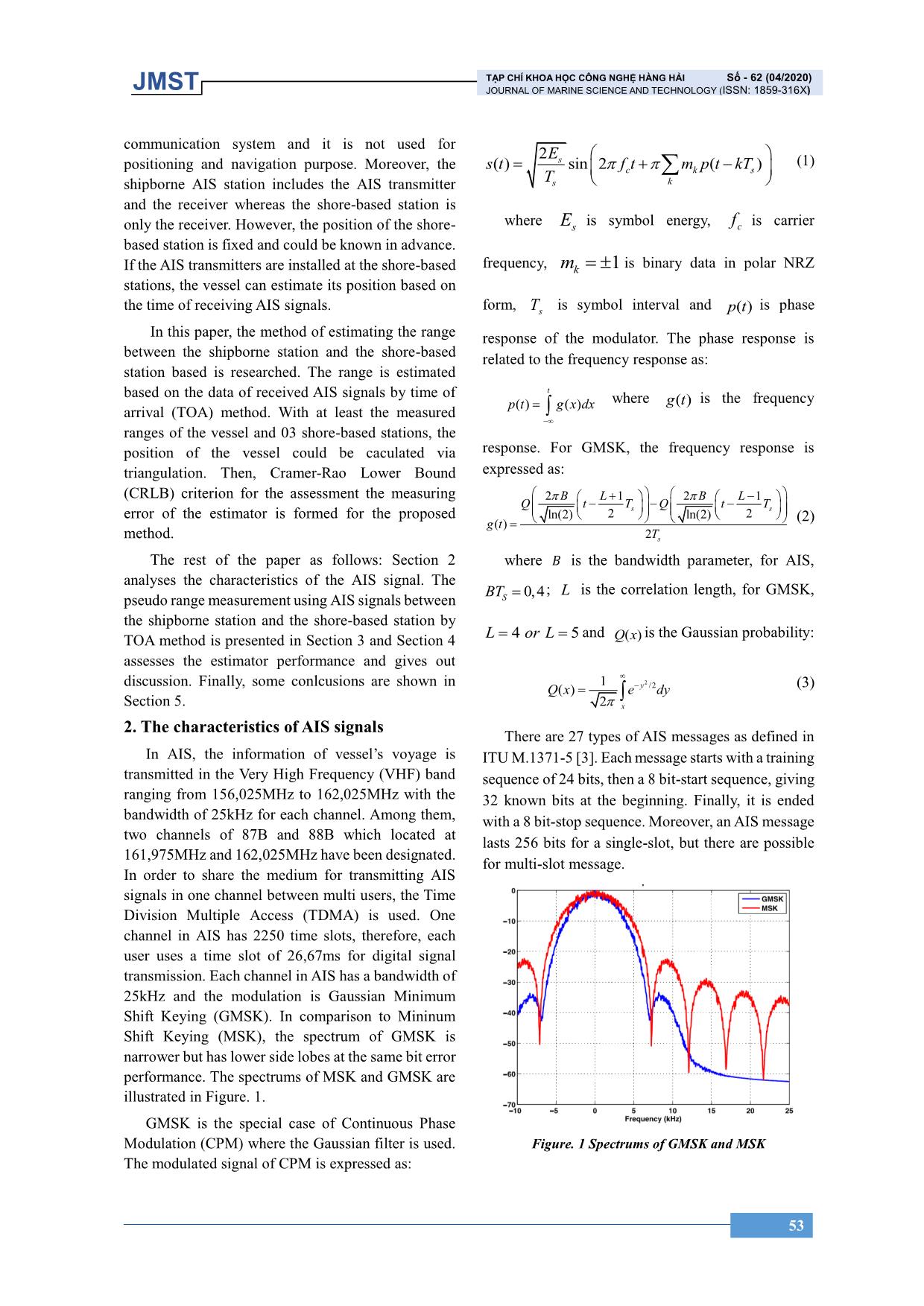
Trang 2
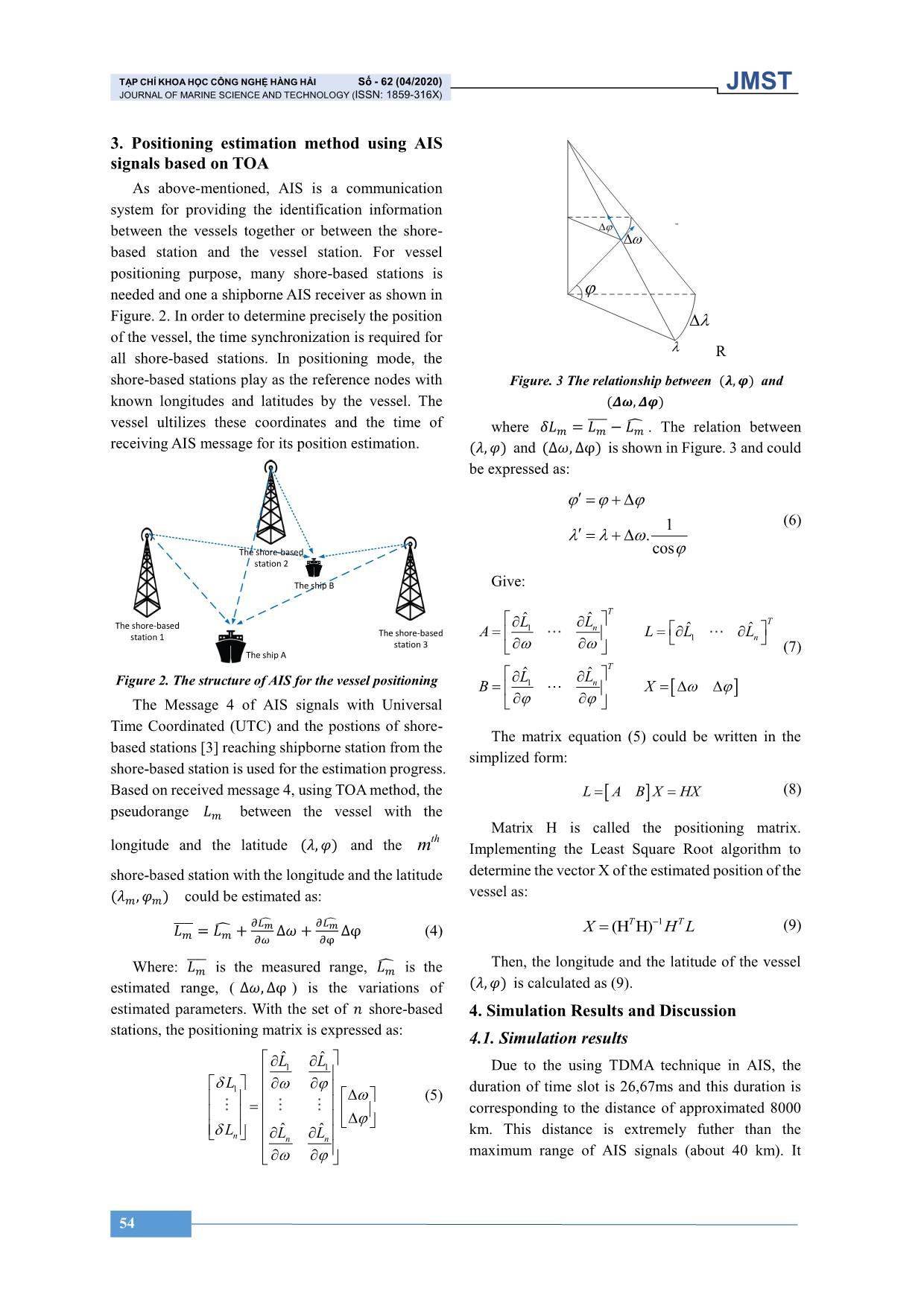
Trang 3
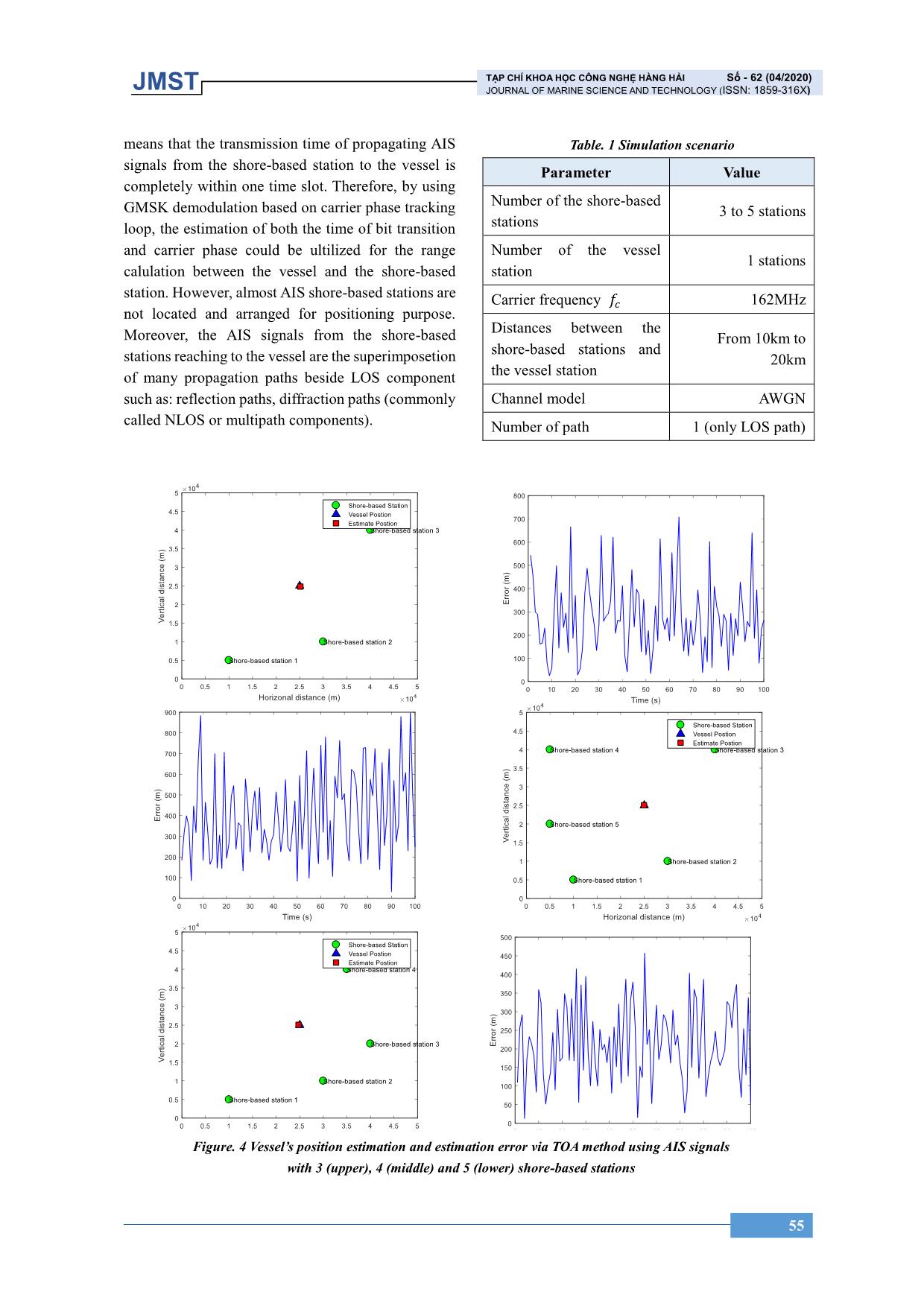
Trang 4
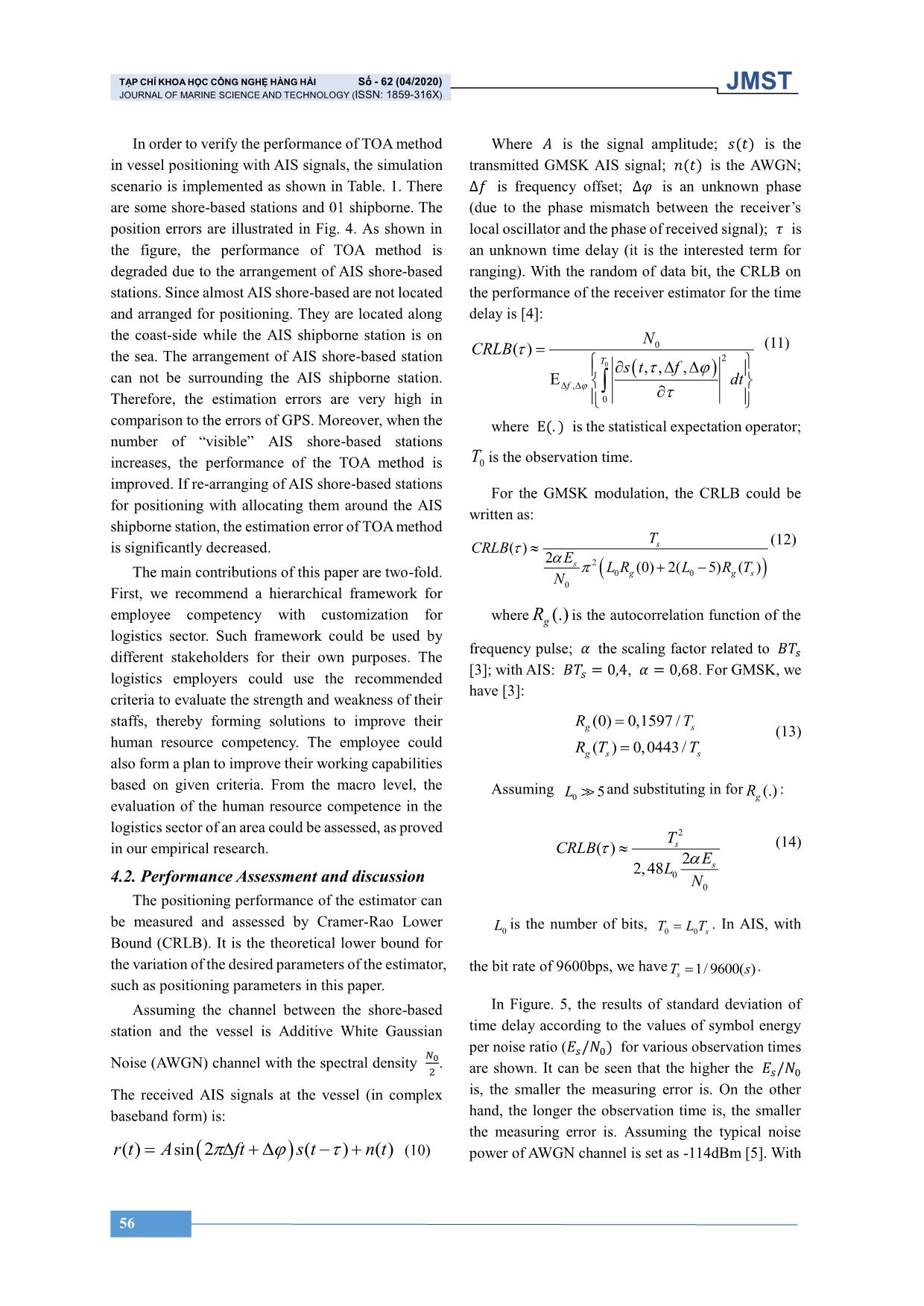
Trang 5
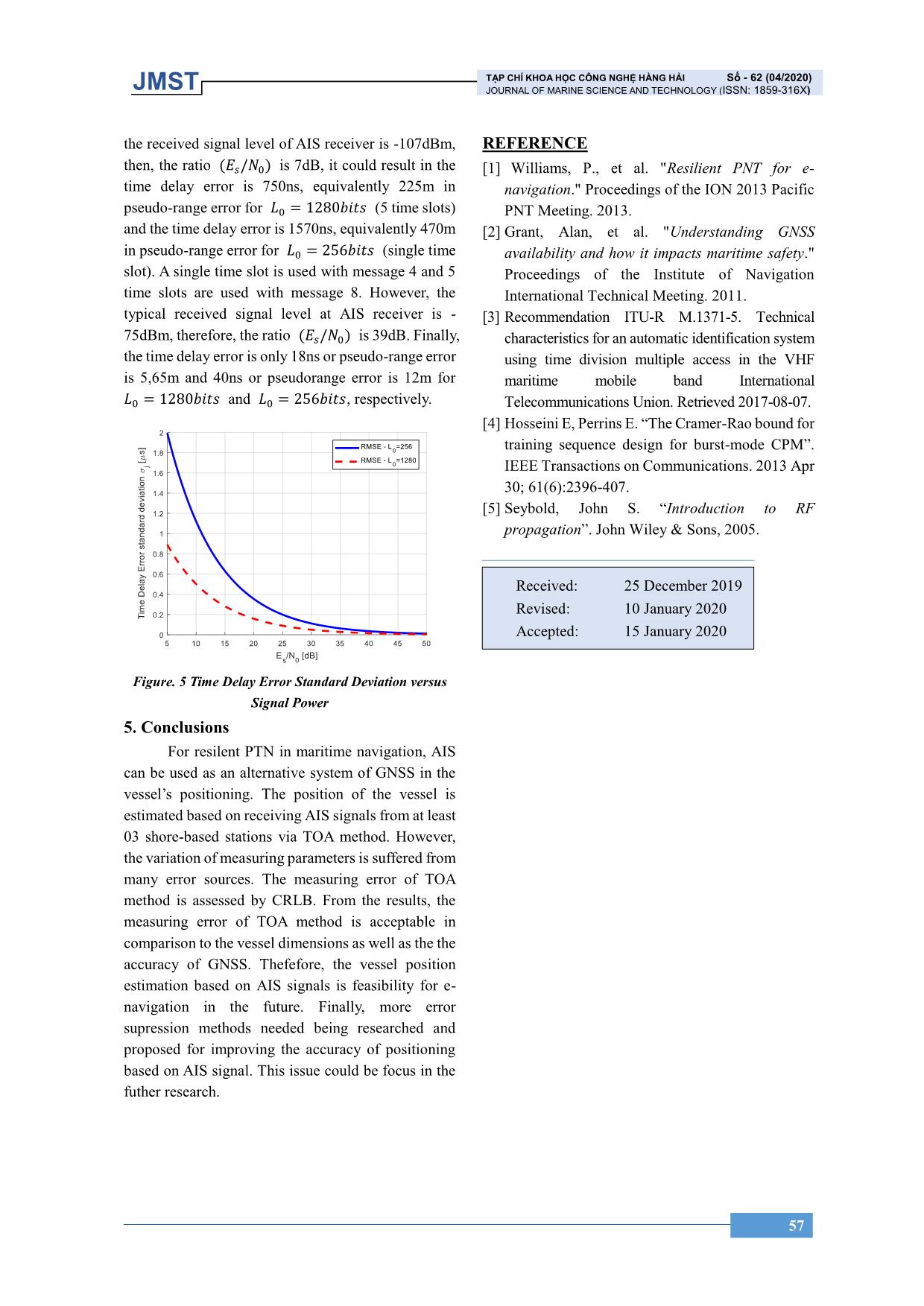
Trang 6
Tóm tắt nội dung tài liệu: Giải pháp ước lượng thời gian tới để định vị tàu biển dựa trên tín hiệu AIS
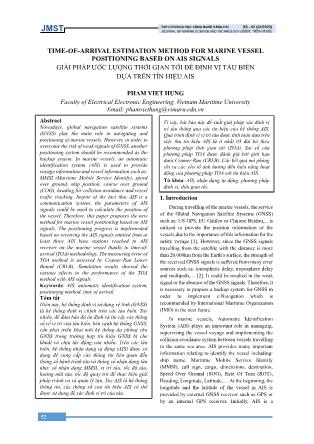
́t quả mô phỏng chỉ ra các yếu tố ảnh hưởng đến hiệu năng hoạt động của phương pháp TOA với tín hiệu AIS. Từ khóa: AIS, nhận dạng tự động, phương pháp định vị, thời gian tới. 53 TẠP CHÍ KHOA HỌC CÔNG NGHỆ HÀNG HẢI Số - 62 (04/2020) JOURNAL OF MARINE SCIENCE AND TECHNOLOGY (ISSN: 1859-316X) JMST communication system and it is not used for positioning and navigation purpose. Moreover, the shipborne AIS station includes the AIS transmitter and the receiver whereas the shore-based station is only the receiver. However, the position of the shore- based station is fixed and could be known in advance. If the AIS transmitters are installed at the shore-based stations, the vessel can estimate its position based on the time of receiving AIS signals. In this paper, the method of estimating the range between the shipborne station and the shore-based station based is researched. The range is estimated based on the data of received AIS signals by time of arrival (TOA) method. With at least the measured ranges of the vessel and 03 shore-based stations, the position of the vessel could be caculated via triangulation. Then, Cramer-Rao Lower Bound (CRLB) criterion for the assessment the measuring error of the estimator is formed for the proposed method. The rest of the paper as follows: Section 2 analyses the characteristics of the AIS signal. The pseudo range measurement using AIS signals between the shipborne station and the shore-based station by TOA method is presented in Section 3 and Section 4 assesses the estimator performance and gives out discussion. Finally, some conlcusions are shown in Section 5. 2. The characteristics of AIS signals In AIS, the information of vessel’s voyage is transmitted in the Very High Frequency (VHF) band ranging from 156,025MHz to 162,025MHz with the bandwidth of 25kHz for each channel. Among them, two channels of 87B and 88B which located at 161,975MHz and 162,025MHz have been designated. In order to share the medium for transmitting AIS signals in one channel between multi users, the Time Division Multiple Access (TDMA) is used. One channel in AIS has 2250 time slots, therefore, each user uses a time slot of 26,67ms for digital signal transmission. Each channel in AIS has a bandwidth of 25kHz and the modulation is Gaussian Minimum Shift Keying (GMSK). In comparison to Mininum Shift Keying (MSK), the spectrum of GMSK is narrower but has lower side lobes at the same bit error performance. The spectrums of MSK and GMSK are illustrated in Figure. 1. GMSK is the special case of Continuous Phase Modulation (CPM) where the Gaussian filter is used. The modulated signal of CPM is expressed as: 2 ( ) sin 2 ( )s c k s ks E s t f t m p t kT T (1) where sE is symbol energy, cf is carrier frequency, 1km is binary data in polar NRZ form, sT is symbol interval and ( )p t is phase response of the modulator. The phase response is related to the frequency response as: ( ) ( ) t p t g x dx where ( )g t is the frequency response. For GMSK, the frequency response is expressed as: 2 1 2 1 2 2ln(2) ln(2) ( ) 2 s s s B L B L Q t T Q t T g t T (2) where 𝐵 is the bandwidth parameter, for AIS, 0,4SBT ; L is the correlation length, for GMSK, 4 5L or L and ( )Q x is the Gaussian probability: 2 /21( ) 2 y x Q x e dy (3) There are 27 types of AIS messages as defined in ITU M.1371-5 [3]. Each message starts with a training sequence of 24 bits, then a 8 bit-start sequence, giving 32 known bits at the beginning. Finally, it is ended with a 8 bit-stop sequence. Moreover, an AIS message lasts 256 bits for a single-slot, but there are possible for multi-slot message. Figure. 1 Spectrums of GMSK and MSK TẠP CHÍ KHOA HỌC CÔNG NGHỆ HÀNG HẢI Số - 62 (04/2020) JOURNAL OF MARINE SCIENCE AND TECHNOLOGY (ISSN: 1859-316X) JMST 54 3. Positioning estimation method using AIS signals based on TOA As above-mentioned, AIS is a communication system for providing the identification information between the vessels together or between the shore- based station and the vessel station. For vessel positioning purpose, many shore-based stations is needed and one a shipborne AIS receiver as shown in Figure. 2. In order to determine precisely the position of the vessel, the time synchronization is required for all shore-based stations. In positioning mode, the shore-based stations play as the reference nodes with known longitudes and latitudes by the vessel. The vessel ultilizes these coordinates and the time of receiving AIS message for its position estimation. The ship B The shore-based station 2 The shore-based station 3 The ship A The shore-based station 1 Figure 2. The structure of AIS for the vessel positioning The Message 4 of AIS signals with Universal Time Coordinated (UTC) and the postions of shore- based stations [3] reaching shipborne station from the shore-based station is used for the estimation progress. Based on received message 4, using TOA method, the pseudorange 𝐿𝑚 between the vessel with the longitude and the latitude (𝜆, 𝜑) and the thm shore-based station with the longitude and the latitude (𝜆𝑚, 𝜑𝑚) could be estimated as: 𝐿𝑚̅̅ ̅̅ = 𝐿�̂� + 𝜕𝐿�̂� 𝜕𝜔 Δ𝜔 + 𝜕𝐿�̂� 𝜕φ Δφ (4) Where: 𝐿𝑚̅̅ ̅̅ is the measured range, 𝐿�̂� is the estimated range, ( Δ𝜔, Δφ ) is the variations of estimated parameters. With the set of 𝑛 shore-based stations, the positioning matrix is expressed as: 1 1 1 ˆ ˆ ˆ ˆ n n n L L L L L L (5) R Figure. 3 The relationship between (𝝀, 𝝋) and (𝜟𝝎, 𝜟𝝋) where 𝛿𝐿𝑚 = 𝐿𝑚̅̅ ̅̅ − 𝐿�̂� . The relation between (𝜆, 𝜑) and (Δ𝜔, Δφ) is shown in Figure. 3 and could be expressed as: 1 . cos (6) Give: 1 1 1 ˆˆ ˆ ˆ ˆˆ T T n n T n LL A L L L LL B X (7) The matrix equation (5) could be written in the simplized form: L A B X HX (8) Matrix H is called the positioning matrix. Implementing the Least Square Root algorithm to determine the vector X of the estimated position of the vessel as: 1(H H)T TX H L (9) Then, the longitude and the latitude of the vessel (𝜆, 𝜑) is calculated as (9). 4. Simulation Results and Discussion 4.1. Simulation results Due to the using TDMA technique in AIS, the duration of time slot is 26,67ms and this duration is corresponding to the distance of approximated 8000 km. This distance is extremely futher than the maximum range of AIS signals (about 40 km). It 55 TẠP CHÍ KHOA HỌC CÔNG NGHỆ HÀNG HẢI Số - 62 (04/2020) JOURNAL OF MARINE SCIENCE AND TECHNOLOGY (ISSN: 1859-316X) JMST means that the transmission time of propagating AIS signals from the shore-based station to the vessel is completely within one time slot. Therefore, by using GMSK demodulation based on carrier phase tracking loop, the estimation of both the time of bit transition and carrier phase could be ultilized for the range calulation between the vessel and the shore-based station. However, almost AIS shore-based stations are not located and arranged for positioning purpose. Moreover, the AIS signals from the shore-based stations reaching to the vessel are the superimposetion of many propagation paths beside LOS component such as: reflection paths, diffraction paths (commonly called NLOS or multipath components). Table. 1 Simulation scenario Parameter Value Number of the shore-based stations 3 to 5 stations Number of the vessel station 1 stations Carrier frequency 𝑓𝑐 162MHz Distances between the shore-based stations and the vessel station From 10km to 20km Channel model AWGN Number of path 1 (only LOS path) Figure. 4 Vessel’s position estimation and estimation error via TOA method using AIS signals with 3 (upper), 4 (middle) and 5 (lower) shore-based stations Table. 1 Simulation scenario TẠP CHÍ KHOA HỌC CÔNG NGHỆ HÀNG HẢI Số - 62 (04/2020) JOURNAL OF MARINE SCIENCE AND TECHNOLOGY (ISSN: 1859-316X) JMST 56 In order to verify the performance of TOA method in vessel positioning with AIS signals, the simulation scenario is implemented as shown in Table. 1. There are some shore-based stations and 01 shipborne. The position errors are illustrated in Fig. 4. As shown in the figure, the performance of TOA method is degraded due to the arrangement of AIS shore-based stations. Since almost AIS shore-based are not located and arranged for positioning. They are located along the coast-side while the AIS shipborne station is on the sea. The arrangement of AIS shore-based station can not be surrounding the AIS shipborne station. Therefore, the estimation errors are very high in comparison to the errors of GPS. Moreover, when the number of “visible” AIS shore-based stations increases, the performance of the TOA method is improved. If re-arranging of AIS shore-based stations for positioning with allocating them around the AIS shipborne station, the estimation error of TOA method is significantly decreased. The main contributions of this paper are two-fold. First, we recommend a hierarchical framework for employee competency with customization for logistics sector. Such framework could be used by different stakeholders for their own purposes. The logistics employers could use the recommended criteria to evaluate the strength and weakness of their staffs, thereby forming solutions to improve their human resource competency. The employee could also form a plan to improve their working capabilities based on given criteria. From the macro level, the evaluation of the human resource competence in the logistics sector of an area could be assessed, as proved in our empirical research. 4.2. Performance Assessment and discussion The positioning performance of the estimator can be measured and assessed by Cramer-Rao Lower Bound (CRLB). It is the theoretical lower bound for the variation of the desired parameters of the estimator, such as positioning parameters in this paper. Assuming the channel between the shore-based station and the vessel is Additive White Gaussian Noise (AWGN) channel with the spectral density 𝑁0 2 . The received AIS signals at the vessel (in complex baseband form) is: sin( ) 2 ( ) ( )r t A ft s t n t (10) Where 𝐴 is the signal amplitude; 𝑠(𝑡) is the transmitted GMSK AIS signal; 𝑛(𝑡) is the AWGN; ∆𝑓 is frequency offset; ∆𝜑 is an unknown phase (due to the phase mismatch between the receiver’s local oscillator and the phase of received signal); 𝜏 is an unknown time delay (it is the interested term for ranging). With the random of data bit, the CRLB on the performance of the receiver estimator for the time delay is [4]: 0 0 2 , 0 ( ) , , , T f N CRLB s t f dt (11) where Ε(. ) is the statistical expectation operator; 0T is the observation time. For the GMSK modulation, the CRLB could be written as: 2 0 0 0 ( ) 2 (0) 2( 5) ( ) s s g g s T CRLB E L R L R T N (12) where (.)gR is the autocorrelation function of the frequency pulse; 𝛼 the scaling factor related to 𝐵𝑇𝑠 [3]; with AIS: 𝐵𝑇𝑠 = 0,4, 𝛼 = 0,68. For GMSK, we have [3]: (0) 0,1597 / ( ) 0,0443 / g s g s s R T R T T (13) Assuming 0 5L and substituting in for (.)gR : 2 0 0 ( ) 2 2,48 s s T CRLB E L N (14) 0L is the number of bits, 0 0 sT L T . In AIS, with the bit rate of 9600bps, we have 1/ 9600( )sT s . In Figure. 5, the results of standard deviation of time delay according to the values of symbol energy per noise ratio (𝐸𝑠/𝑁0) for various observation times are shown. It can be seen that the higher the 𝐸𝑠/𝑁0 is, the smaller the measuring error is. On the other hand, the longer the observation time is, the smaller the measuring error is. Assuming the typical noise power of AWGN channel is set as -114dBm [5]. With 57 TẠP CHÍ KHOA HỌC CÔNG NGHỆ HÀNG HẢI Số - 62 (04/2020) JOURNAL OF MARINE SCIENCE AND TECHNOLOGY (ISSN: 1859-316X) JMST the received signal level of AIS receiver is -107dBm, then, the ratio (𝐸𝑠/𝑁0) is 7dB, it could result in the time delay error is 750ns, equivalently 225m in pseudo-range error for 𝐿0 = 1280𝑏𝑖𝑡𝑠 (5 time slots) and the time delay error is 1570ns, equivalently 470m in pseudo-range error for 𝐿0 = 256𝑏𝑖𝑡𝑠 (single time slot). A single time slot is used with message 4 and 5 time slots are used with message 8. However, the typical received signal level at AIS receiver is - 75dBm, therefore, the ratio (𝐸𝑠/𝑁0) is 39dB. Finally, the time delay error is only 18ns or pseudo-range error is 5,65m and 40ns or pseudorange error is 12m for 𝐿0 = 1280𝑏𝑖𝑡𝑠 and 𝐿0 = 256𝑏𝑖𝑡𝑠, respectively. Figure. 5 Time Delay Error Standard Deviation versus Signal Power 5. Conclusions For resilent PTN in maritime navigation, AIS can be used as an alternative system of GNSS in the vessel’s positioning. The position of the vessel is estimated based on receiving AIS signals from at least 03 shore-based stations via TOA method. However, the variation of measuring parameters is suffered from many error sources. The measuring error of TOA method is assessed by CRLB. From the results, the measuring error of TOA method is acceptable in comparison to the vessel dimensions as well as the the accuracy of GNSS. Thefefore, the vessel position estimation based on AIS signals is feasibility for e- navigation in the future. Finally, more error supression methods needed being researched and proposed for improving the accuracy of positioning based on AIS signal. This issue could be focus in the futher research. REFERENCE [1] Williams, P., et al. "Resilient PNT for e- navigation." Proceedings of the ION 2013 Pacific PNT Meeting. 2013. [2] Grant, Alan, et al. "Understanding GNSS availability and how it impacts maritime safety." Proceedings of the Institute of Navigation International Technical Meeting. 2011. [3] Recommendation ITU-R M.1371-5. Technical characteristics for an automatic identification system using time division multiple access in the VHF maritime mobile band International Telecommunications Union. Retrieved 2017-08-07. [4] Hosseini E, Perrins E. “The Cramer-Rao bound for training sequence design for burst-mode CPM”. IEEE Transactions on Communications. 2013 Apr 30; 61(6):2396-407. [5] Seybold, John S. “Introduction to RF propagation”. John Wiley & Sons, 2005. Received: 25 December 2019 Revised: 10 January 2020 Accepted: 15 January 2020
File đính kèm:
 giai_phap_uoc_luong_thoi_gian_toi_de_dinh_vi_tau_bien_dua_tr.pdf
giai_phap_uoc_luong_thoi_gian_toi_de_dinh_vi_tau_bien_dua_tr.pdf

